Publicado el: 14 de febrero de 2014
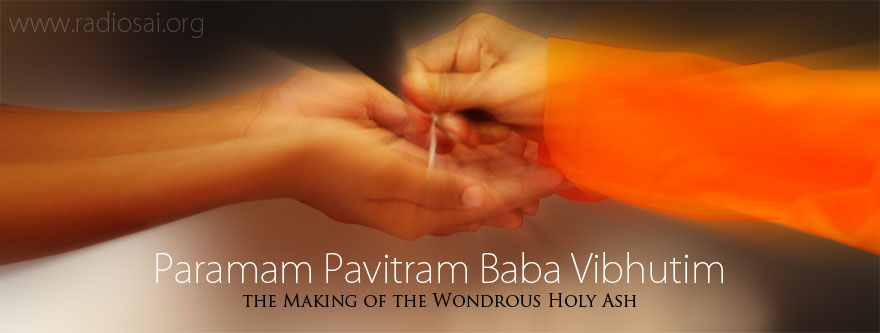 |
Se llama Vibhuti porque le da a uno prosperidad; Bhasma - 'cenizas' porque quema todos los pecados; Bhasitam - 'iluminado' porque aumenta el esplendor espiritual de uno; Ksharam - 'destrucción' ya que elimina el peligro; y Raksha - 'protector' porque es una armadura contra las maquinaciones de los espíritus malignos. Así es como se alaba al Vibhuti en el Brihad Jabala Upanishad, uno de los antiguos textos espirituales. Vibhuti es una palabra que se usa generalmente para denotar la ceniza sagrada que los devotos hindúes aplican principalmente a su frente. Se forma como el residuo de madera quemada y tortas secas de estiércol de vaca que se utilizan en el rito védico del Yajna.(sacrificio de fuego). La palabra 'vibhuti' y la ceniza tienen varios significados y simbolismos en varios niveles. El más importante de ellos es la verdad de que la ceniza es el destino final de todo lo mundano y material. El punto de vibhuti en la frente es un fuerte recordatorio para el hombre de que el mundo es transitorio y temporal, por lo que debe dedicar su tiempo y su vida a actividades acordes con el nacimiento humano. Y esta es la búsqueda del tesoro / riqueza suprema: la verdadera identidad de uno; la respuesta a la pregunta, "¿Quién soy yo?"
La palabra 'vibhuti' también denota esta misma búsqueda. En el idioma divino, sánscrito, bhuti se refiere a aishwaryam (riqueza o tesoro). Vise refiere a algo que es valioso más allá de la imaginación. El tesoro más grande y valioso es "esa búsqueda que no es necesario buscar nunca más" o "ese saber que sabe todo". Y ESA es la razón por la que a menudo se dice que quien usa vibhuti no necesita usar nada más. ESA es la razón por la que el gran Señor Shiva es alabado con el epíteto, "Digambara" (uno que se viste solo con los cielos) porque "usa" vibhuti sobre sí mismo. Shiva 'vistiendo' vibhuti transmite la verdad de que Él está aislado de toda existencia, ¡aunque está cubierto por la misma cosa! Vibhuti también recuerda la historia de la incineración de Kama Deva (el dios de los deseos) por el Señor Shiva, cuyo mensaje es que, en última instancia, los deseos se convierten en polvo (vibhuti).
El poder de Vibhuti
 | |
¡A menudo ignoramos inocentemente la maravilla de ese puntito brillante en la frente! |
Cuando era niño había escuchado una pequeña pero inolvidable historia sobre el poder del vibhuti . Aparentemente, un devoto del Señor adornado con un punto brillante de vibhuti en la frente estaba atravesando un bosque. En el bosque, se encontró con un pozo maldito. Esto, cuenta la historia, fue el pozo al infierno. El viajero escuchó gemidos y gritos que emanaban del pozo. Curiosamente, se acercó a él y se asomó. En el momento en que hizo eso, cesaron todos los gemidos y gritos.
Desconcertado, cuando se volvió para caminar, los gritos comenzaron de nuevo. Entonces, fue una vez más al pozo y se asomó, solo para encontrarse con un silencio absoluto. Esto sucedió varias veces. Completamente confundido, caminó hacia el pozo y preguntó:
"¡Hola! ¿Hay alguien ahí abajo?
No hubo respuesta. Decidiendo que el pozo estaba asustado, cuando el viajero estaba a punto de alejarse, escuchó una voz,
"¡Señor! ¡Por favor no te vayas! Este es el pozo que conduce al infierno. Todos estamos sufriendo aquí. Es tu presencia lo que nos alivia ".
Sorprendido, el hombre preguntó:
"¿Cómo es que mi presencia les da consuelo? ¡No soy un santo ni un redentor! "
"¡Señor, cada vez que miras al pozo, una pizca de vibhuti cae dentro de tu frente! Eso nos da un gran alivio ".
La historia ha permanecido en mi corazón desde entonces y respeto y adoro vibhuti desde el fondo de mi corazón.
Paramam Pavitram Baba Vibhutim
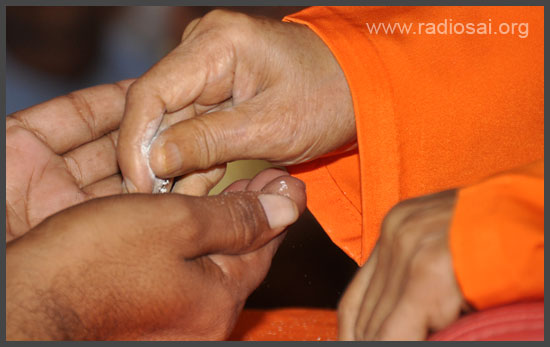 | |
La panacea para todos los males - mundanos y de otro mundo |
Vibhuti también adquiere especial interés y significado para los devotos de Bhagavan Sri Sathya Sai Baba. Desde los días de Su niñez, desde que declaró Su Avatar, Baba materializó vibhuti de la nada y lo prescribió para todo tipo de enfermedades y como todo tipo de bendiciones, mundanas y espirituales. El Vibhuti que Él dio fue de innumerables clases, adecuado a los diferentes propósitos para los que fue creado. A veces tenía la forma de un cubo duro, aunque más a menudo era un polvo: fino, granulado o escamoso. Puede ser fragante o picante, salado o dulce o, a veces, absolutamente insípido. En color, era blanco o negruzco, o de cualquiera de los tonos intermedios. A veces, cuando Él agitó Su Mano, vibhuti se materializó - ¡contenedor y todo! Tal es la asociación de Baba con vibhuti que Su biógrafo, el Prof. N. Kasturi,El movimiento de la Mano "para grabarlo.
De hecho, Swami ha elevado Vibhuti a una especie de "tarjeta de identidad" para un devoto Sai. En un verso que canta con su voz melodiosa, proclama:
Kolanuku Kaluvaye Shringaaramu
Aakashamunaku Chandrude Shringaaramu
Samudramunaku Alale Shringaaramu
Swami Bhaktulaku Vibhutiye Shringaaramu
(Los lotos son los adornos del lago. La luna es la decoración de los cielos. Las olas decoran el océano. De manera similar, vibhuti es el adorno para los devotos de Swami).
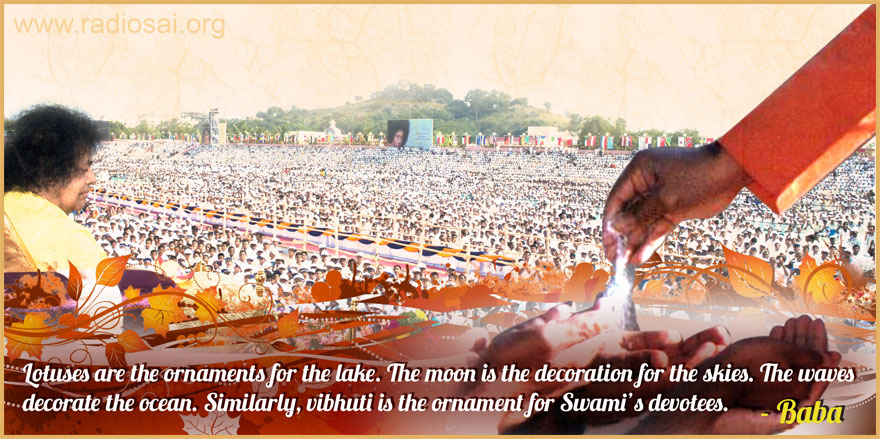 |
Entonces, no es sorprendente que durante algunos festivales como Dasara y Mahashivarathri, Swami manifestara y distribuyera copiosas cantidades de vibhuti. El video a continuación dará una idea de uno de estos eventos magníficos, materialización y distribución, durante el día Vijayadashami de Dasara.
Vibhuti hoy en día se ha convertido en Mahaprasadam (obsequio de gracia otorgado a todos los devotos como muestra de las bendiciones del Maestro) en cualquier reunión, local o internacional, que tenga lugar en el nombre de Bhagavan Sri Sathya Sai Baba.
Conociendo el Vibhuti 'HIS'tory
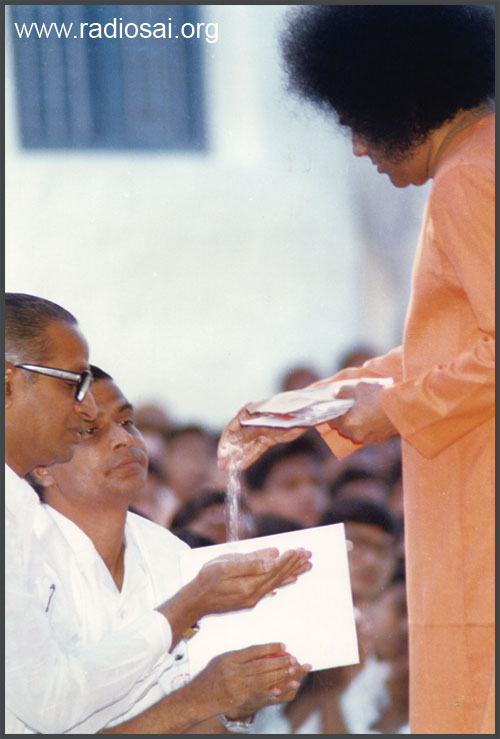 | |
Incluso el vibhuti que se 'fabricó' por primera vez lo hicieron directamente las Manos Divinas. |
Desde la erección del ashram de Prashanti Nilayam, las multitudes que se reunieron en Puttaparthi no hicieron más que aumentar. Puttaparthi se convirtió en un centro de peregrinaje para personas de todas las religiones y regiones del mundo. Era apropiado que algo tan universal como la ceniza se convirtiera en el Prasad que los devotos buscaban en esta morada Universal de Paz Suprema. Los 'afortunados' consiguieron materializar vibhuti con la ola divina de la palma. Pero todos querían una pizca de la ceniza sagrada para ellos y también para llevarse a casa como muestra de las bendiciones de Baba. Fue entonces cuando Swami instituyó personalmente un procedimiento para la 'fabricación' de vibhuti.
Cuenta la leyenda que Swami mismo recogió y limpió el estiércol de vaca, lo secó y lo quemó hasta convertirlo en cenizas. Estas cenizas se tamizaron y se pulverizaron finamente para dar como resultado la primera edición del vibhuti de Puttaparthi. Un pequeño paquete de papel de esta ceniza estaba disponible para que cualquier visitante del ashram lo buscara antes de partir hacia su ciudad natal. Fue en algún momento de la década de 1980 que el Sr. Khialdas, la persona encargada de cuidar los almacenes generales de la cooperativa para el bienestar de los devotos, se acercó a Swami con una solicitud. Le dijo a Swami que los devotos querían llevarse enormes cantidades de vibhuti a sus respectivos países y ciudades. No haba forma de que el pequeo vibhutiser "fabricado" bastaría para satisfacer incluso una parte de la demanda. Por lo tanto, buscó las bendiciones de Swami para establecer un elaborado sistema de fabricación de vibhuti después del cual el mismo podría venderse a un costo muy bajo. Había llegado el momento de que la misión Sai del Amor cambiara de marcha y Bhagavan Baba amablemente permitió la aventura.
Un pequeño desvío para explicar el doble propósito de este artículo es relevante aquí. Hay una noción errónea entre muchos de que todo el vibhuti que compran en el ashram (a Rs 2 / - por paquete de 100 gramos) ha sido "materializado" por Swami y almacenado en una enorme cámara para su distribución a través de dichos paquetes. Por supuesto, el vibhuti ha sido "creado" por Swami en el mismo sentido en que el Universo ha sido creado por Él; tú y yo fuimos creados por él. Pero así como el Big Bang fue el instrumento del Señor para la creación del Universo y los padres son Sus instrumentos para llevarnos al mundo, hay un proceso instrumental que también derrama el vibhuti Divino .
El primer propósito del artículo es educar al lector sobre el conocimiento y los detalles de este proceso. El segundo propósito es responder detalladamente a la pregunta: "¿ahora cómo se hace el vibhuti?"
Desde que Swami acordó la fabricación y venta de vibhuti en 1986, la ceniza cruda ha sido obtenida de un fabricante y proveedor en Palani, Tamil Nadu. Este vibhuti crudo está constituido principalmente por cascarilla y ceniza con trazas de estiércol de vaca (menos del 1%). Esta ceniza llega a Prashanti Nilayam empaquetada en bolsas de 50 kg. Entonces comienza el trabajo de amor en el que cuatro perfumes diferentes se mezclan en el vibhuti en proporciones que Swami le dio a cierta dama, llamada Bujamma.
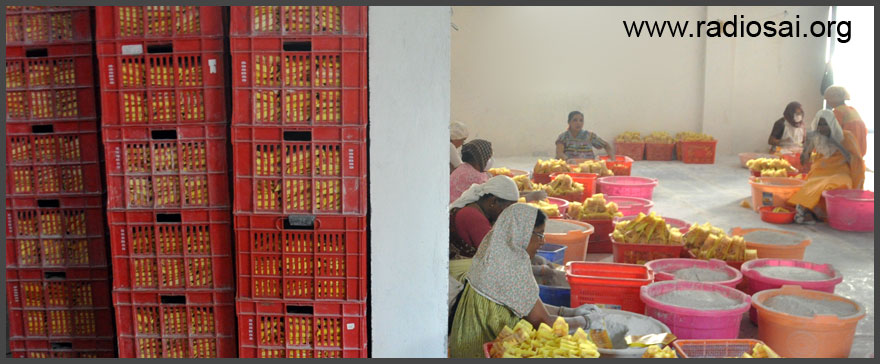 |
Una pared en el cobertizo de 'fabricación' separa las obras en proceso de los 'bienes' empaquetados. |
Se seleccionaron dos perfumes sólidos y dos perfumes líquidos de entre docenas que Khialdas trajo a Swami. Swami llamó a Bujamma y le indicó que mezclara unas cuantas cucharadas de cada uno de los perfumes líquidos y unas cuantas cucharadas de cada uno de los perfumes sólidos en 40 bolsas de vibhuti sin perfume que llegaban de Palani. (Las medidas exactas están retenidas. La formulación exacta es un secreto tan guardado como la famosa 'fórmula de Coca-Cola'. La formulación se transfiere solo de boca en boca y no se escribe en ninguna parte). Eso hace un total de unos pocos gramos. de perfume en 2000 kg de vibhuti. La frase 'unos gramos' es correcta porque incluso hoy en día se usan las mismas cucharas para agregar los perfumes. ¡Las balanzas electrónicas no se utilizan para la proporción!
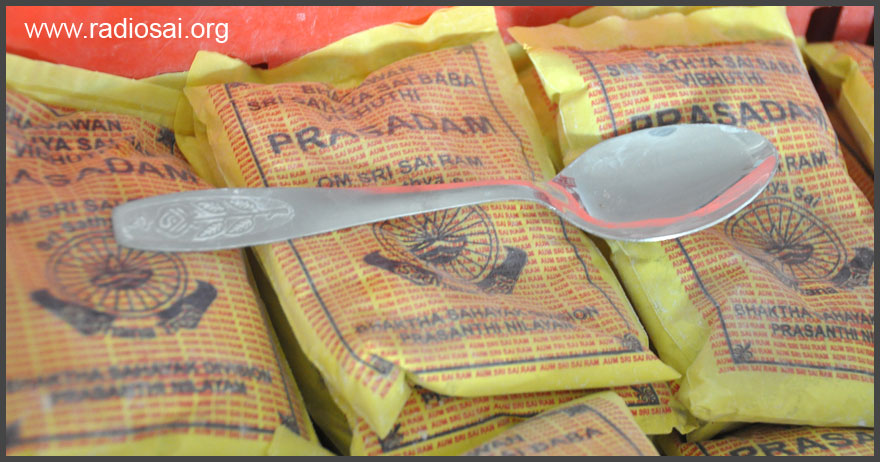 |
La cuchara bendita que se utiliza hasta el día de hoy para medir los distintos perfumes para ofrecer la fórmula "perfecta". |
A Bujjamma se le confió el deber sagrado de mezclar los perfumes en el vibhuti en la proporción prescrita. Con la ayuda de algunos trabajadores varones, ella realizaría sincera y concienzudamente su sadhana diario de 'crear' vibhuti. La mezcla tenía que ser completa y eso en sí mismo llevaría varias horas. Una vez que se completó la mezcla, la ardua tarea de empacar tuvo que completarse antes de que los paquetes de vibhuti estuvieran listos para los devotos.
Un día, Khialdas y varios otros le dijeron a Bujjamma que el vibhuti no era lo suficientemente fragante. ¿Podría agregar un poco de perfume extra? Mientras reflexionaba sobre esta sugerencia, su Señor la visitó en un sueño. Allí, le advirtió estrictamente que no aumentara la proporción dada. Por otro lado, le dijo que redujera el perfume sólido a solo la mitad de la prescripción original para las 40 bolsas de vibhuti. El cambio ordenado divinamente se incorporó y las proporciones han permanecido iguales desde entonces.
El 'ahora-cómo' del proceso de fabricación de vibhuti
Con curiosidad por saber más sobre el método de fabricación de vibhuti 'aprobado por Swami' y 'dotado de Swami', me dirigí al enorme complejo comercial de Sri Sathya Sai Bhakta Sahayak Sangh en Prashanti Nilayam. En una esquina de la planta baja había enormes bandejas apiladas con paquetes de 100 g de ceniza sagrada. Me acerqué al Sr. Doraiswamy, que se ocupa de la fabricación de vibhuti en Prashanti Nilayam. Los detalles que compartió conmigo fueron alucinantes.
¿Puede hacer una estimación de la cantidad de vibhuti que se desembolsa en un año de Prashanti Nilayam? De verdad, deja de leer ahora, cierra los ojos y haz una estimación aproximada. Cuando hice esto, pensé que las tiendas posiblemente vendieran unos 5.000 kilogramos de vibhuti al año. El número real me dejó estupefacto. En promedio, cada año se desembolsan unas 100 toneladas métricas de vibhuti: ¡100.000 kilogramos sólidos! De hecho, en 2010, ¡esta cifra fue la friolera de 128 toneladas métricas! ¡Y toda esta cantidad está completamente preparada por personal voluntario que en promedio es de 20 mujeres!
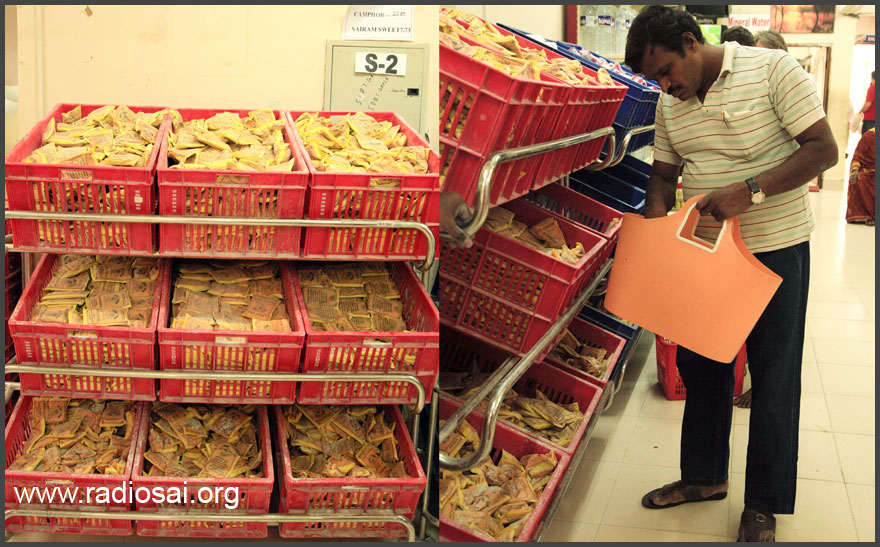 |
¡La sección de las tiendas en Prashanti Nilayam que no gana dinero sino infinitas bendiciones y buenos deseos de los devotos! |
Eso, naturalmente, estimuló en mí el deseo de visitar el cobertizo que actualmente se utiliza como sitio para esta fabricación. Incluso mientras me acercaba al cobertizo detrás de los bloques de alojamiento en el lado norte del ashram, la fragancia de la ceniza sagrada flotaba en mi ser. Me sentí tan recargado. Al entrar en el cobertizo, vi que había entre 15 y 20 mujeres, silenciosa y eficientemente realizando su tarea de empacar el vibhuti. Uno o dos de ellos levantaron la cabeza para ver quién era el recién llegado recortado en la puerta. Los demás ni siquiera notaron mi presencia. Saqué mi cámara y mostré mi entrada en voz alta. Ahora, algunos de ellos me miraron y les pregunté en voz alta:
"¿Puedo hablar con Sanku Ramaniyamma?"
"Estoy aquí", dijo una señora de unos cincuenta años, sellando los paquetes de vibhuti amarillos. Me acerqué a ella y me presenté. Al escuchar que había venido a escuchar la historia de vibhuti, sus ojos brillaron.
"¿Qué te diré? ¡Has llegado 2 años demasiado tarde! Bujjamma se ha ido a su ciudad natal debido a su avanzada edad. ¡Definitivamente habría narrado cientos de historias relacionadas con la fabricación de vibhuti! "
"¿Quieres decir que hasta 2012 todavía era Bujjamma quien hacía la mezcla de vibhuti?"
 |
La montaña de vibhuti mixto que sale de la máquina se sella en paquetes de plástico amarillos y se almacena en bandejas. |
"¡Sí! Cuando la demanda de vibhuti se hizo muy alta, se trajo una máquina. Pero incluso entonces, fue Bujjamma quien mantuvo las proporciones de los perfumes en el vibhuti. Ella me enseñó cómo hacerlo, diciendo que se iría por unos meses de 'vacaciones'. Más tarde supimos que ella no regresaría ".
Luego, Ramaniyamma dio una descripción detallada de cómo se lleva a cabo el proceso. Un camión llega una o dos veces al mes desde Palani con el vibhuti crudo y descarga los sacos en la bahía de descarga del cobertizo. Ramaniyamma toma una tina llena de vibhuti y agrega los perfumes en sus respectivas proporciones 'cucharadas'. El vibhuti en la tina se mezcla a fondo junto con el canto de los himnos y mantras espirituales (aunque no fijos). Este vibhuti 'concentrado' ahora se distribuye igualmente en 40 bolsas pequeñas. Un trabajador, llamado Ratnakar, que ha estado en la 'planta de fabricación' durante los últimos 40 años, luego agrega un saco de vibhuti crudo en la máquina mezcladora. A esto, agrega una pequeña bolsa de vibhuti 'concentrado'. Durante la siguiente hora, la máquina mezcla y deja caer el vibhuti que está listo para usar.
La evolución del embalaje Vibhuti
Hay unas diez mujeres que, por pura experiencia, colocan aproximadamente 100 g de vibhuti en paquetes amarillos. Estos paquetes pasan a través de los 'equilibradores' que colocan cada paquete en una balanza de pesaje y eliminan / agregan vibhuti para un total exacto de 100 g. Estas mujeres luego pasan los paquetes a los 'selladores' que presionan un mango eléctrico para sellar los paquetes. El prasadam Divino está listo para llegar al devoto ahora.
 |
Los ayudantes del Señor en acción, asegurando que los signos más reconocidos de la gracia de Swami lleguen al hogar de cada devoto en cada rincón del mundo. |
Sin embargo, este proceso de envasado también ha evolucionado durante dos décadas. En 1986, el embalaje original incluía una cubierta de papel amarillo en la que se rellenaba el vibhuti. Para evitar que la humedad empape la ceniza, el paquete de papel se cubriría con una hoja de plástico transparente de color amarillo. Esto luego se ataría con un cordel fino y blanco. Este elaborado envase requería mucha mano de obra.
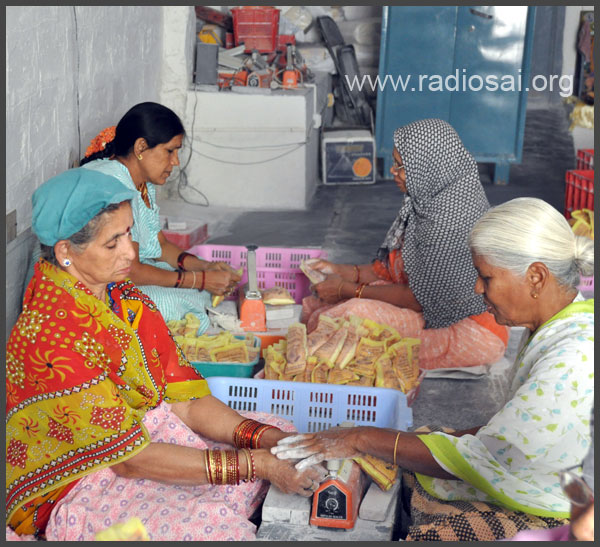 | |
Ramaniyamma (en el fondo en azul claro), además de mezclar el vibhuti, también funciona con la sección de sellado de la prensa eléctrica. |
En 1994, Swami pasó casi 8 meses en el ashram de Brindavan en Whitefield, Bangalore. Naturalmente, las multitudes en Brindavan eran mucho más comparadas con las de Puttaparthi durante ese tiempo. Ese fue el momento en que, con el permiso de Swami, el Sr. Ruchir Desai (profesor en el campus de Brindavan y que hasta la fecha administra las tiendas cooperativas en Brindavan) también comenzó la fabricación de vibhuti en el ashram de Brindavan. Esto era esencial para satisfacer la creciente demanda de vibhuti de los devotos. Ruchir Desai obtuvo con gran dificultad la fórmula de Bujjamma. Bujjamma dio la formulación solo después de recibir la confirmación de que Swami realmente le había dado instrucciones para comenzar a hacer vibhuti en Bangalore. En algunos dias, más de 1000 paquetes se venderían en cuestión de horas e incluso el cambio del proceso de fabricación no pareció resolver el problema de la demanda elevada. El cuello de botella para la producción fue el proceso de empaque. En un intento por aumentar la producción para satisfacer la creciente demanda de los devotos y eliminar este cuello de botella, Ruchir Desai se acercó a Swami.
Informó a Swami sobre el método de empaque existente y buscó bendiciones para un nuevo método de empaque. Se obtuvieron cubiertas de plástico impresas que se podían sellar instantáneamente con una prensa eléctrica caliente. Swami seleccionó el diseño adecuado para la portada y también dio instrucciones sobre lo que debería imprimirse en la portada. Por lo tanto, el empaque moderno que vemos hoy llegó a existir, nuevamente con las bendiciones y el permiso de Swami.
Un verdadero trabajo de amor
Ramaniyamma y su dedicado equipo de voluntarios consideran que es una gran bendición poder empacar el mayor tesoro de la tierra: ¡vibhuti! Una vez les ofrecieron salarios por las 5-6 horas de trabajo duro que realizaban a diario, sin fines de semana, sin vacaciones, pero se negaron rotundamente.
"Esto es algo que deseamos hacer por Swami. ¿Cómo podemos aceptar dinero por ello? "
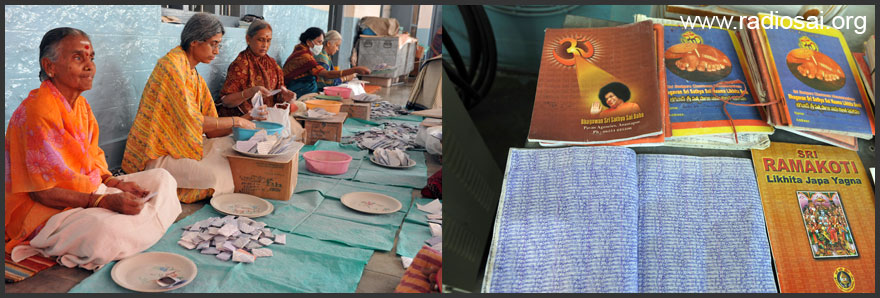 |
Es con Su nombre en sus labios que estos voluntarios desinteresados realizan silenciosamente su gran servicio (izquierda). Los libros de Likhita Japam de todo el mundo aterrizan en Prashanti para ofrecer sus hojas como cubiertas para el vibhuti. (Derecha) |
Lo mismo ocurre en Brindavan también, con el equipo de voluntarios encabezado por la Sra. Bhutia.
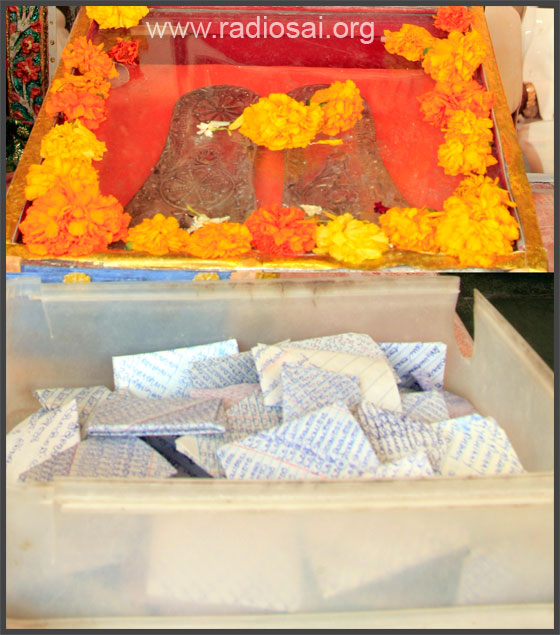 | |
Envuelto en papel con Su nombre, cargado con el canto de Su nombre y listo para difundir la gloria de Su nombre. |
Aparte de esto, es necesario un equipo separado para hacer paquetes de vibhuti que están disponibles como prasadam para cada devoto que visite el ashram, ya sea en la oficina de PRO, la oficina de seguridad o la oficina de alojamiento. Este equipo separado está constituido por mujeres muy mayores, algunas de ellas incluso en sus ochenta, que se sientan durante y después de los bhajans, empacando vibhuti. Al igual que los voluntarios que participan en la fabricación y el embalaje a gran escala, estas mujeres también buscan nada más que Su Amor por sus esfuerzos. Se les puede ver haciendo su actividad silenciosamente detrás del salón de bhajans en Prashanti Nilayam, haciendo pequeños paquetes. Estos son paquetes de 10 gramos que están hechos de las páginas del ' Likhita Nama Japa Sadhana'libros. Estos libros contienen el nombre divino, escrito miles de veces por devotos como parte de su sadhana o práctica espiritual. Una vez que el libro está completo, viaja a los ashrams donde se transforma en el portador y portador de la ceniza sagrada.
Ésa, en resumen, es la historia de la fabricación de vibhuti. Aunque aquí se han presentado muchos detalles, se ha omitido un detalle. Y eso no es porque haya sido olvidado; fue más porque se dio por sentado que todo el mundo lo sabe. ¡El ingrediente más importante del vibhuti es el Amor y la Gracia infinitos de Bhagavan Baba que siempre contiene!
La historia de la fabricación de vibhuti tiene muchas más experiencias y narrativas incrustadas en ella y un artículo nunca será suficiente para capturar toda esa gloria. Pero si algún lector está interesado en conocer estos cuentos más fascinantes, la mejor manera sería unirse a este equipo dedicado y ofrecerse como voluntario para empacar el vibhuti cuando esté en Prashanti Nilayam o Brindavan. Esa sería una situación en la que todos salían ganando. Obtendrá historias fascinantes y la oportunidad de ser parte de este proceso magníficamente divino de hacer el mahaprasadam. El equipo de voluntarios que fabrica el vibhuti recibirá la ayuda que tanto necesita para aumentar su productividad y satisfacer la creciente necesidad de vibhuti en todo el mundo.
Aquellos que deseen ofrecerse en esta labor de amor pueden contactarse amablemente con el PRO (Sr. Murali) del ashram en Prashanti Nilayam. Aquellos que deseen hacer lo mismo en el ashram de Whitefield pueden comunicarse con el Sr. Ruchir Desai.
Paramam Pavitram Baba Vibhutim
Paramam Vichitram Leelaa Vibhutim
Paramaartha Ishtaartha Moksha Pradaanam
Baba Vibhutim Idam Aashrayaami
- Aravind Balasubramanya
Gráficos - Mohan Dora
Posted on: Feb 14, 2014
 |
It is named Vibhuti since it endows one with prosperity; Bhasma - 'ashes' because it burns away all sins; Bhasitam - 'brightened' because it increases one's spiritual splendour; Ksharam - 'destruction' since it removes danger; and Raksha - 'protector' for it is an armour against the machinations of evil spirits. This is how the Vibhuti is praised in the Brihad Jabala Upanishad, one of the ancient spiritual texts. Vibhuti is a word that is generally used to denote the sacred ash which Hindu devotees apply primarily to their forehead. It is formed as the residue of burnt wood and dried cow dung cakes that are used in the Vedic rite of the Yajna (fire-sacrifice). The word 'vibhuti' and the ash have several meanings and symbolisms at several levels. The foremost among these is the truth that ash is the ultimate destination of everything worldly and material. The dot of vibhuti on the forehead is a strong reminder to man that the world is transient and temporary, and so, he must spend his time and life in pursuits that befit the human birth. And this is the pursuit of the ultimate treasure/wealth - one's true identity; the answer to the question, "Who am I?"
The word 'vibhuti' also denotes this very pursuit. In the divine language, Sanskrit, bhuti refers to aishwaryam (wealth or treasure). Vi refers to something that is valuable beyond imagination. The greatest and most valuable treasure is 'that seeking which one need not seek ever again' or 'that knowing which one knows everything'. And THAT is the reason why it is often said that one who wears vibhuti need not wear anything else. THAT is the reason why the great Lord Shiva is praised with the epithet, "Digambara" (one who clothes Himself with the skies alone) because he 'wears' vibhuti all over Himself. Shiva 'wearing' vibhuti conveys the truth that He is insulated from all existence though He is covered by the very same thing! Vibhuti also calls to mind the story of incineration of Kama Deva (the god of desires) by Lord Shiva, the message of which is that, ultimately desires become dust (vibhuti).
The Power of Vibhuti
 | |
We are often innocently ignorant of the marvel of that bright little dot on the forehead! |
It was as a child that I had heard a small but unforgettable story on the power of vibhuti. Apparently, a devotee of the Lord adorned with a bright dot of vibhuti on the forehead was passing through a forest. In the forest, he came across an accursed well. This, the story goes, was the well to hell. The traveller heard groans and shouts emanating from the well. Curiously, he walked to it and peeped into it. The minute he did that, all the groaning and screaming ceased.
Puzzled, as he turned to walk on, the shouting started again. So, he went once more to the well and peeped in, only to be met with absolute silence. This happened several times over. Thoroughly confused, he walked to the well and asked,
"Hello! Anybody down there?"
There was no answer. Deciding that the well was spooked, when the traveller was about to walk away, he heard a voice,
"Sir! Please do not go away! This is the well that leads to hell. We are all suffering here. It is your presence that gives us relief."
Surprised, the man asked,
"How is it that my presence gives you comfort? I am no saint or redeemer!"
"Sir, every time you peep down into the well, a sprinkle of vibhuti falls inside from your forehead! That gives us great relief."
The story has remained in my heart ever since and I respect and adore vibhuti from the bottom of my heart.
Paramam Pavitram Baba Vibhutim
 | |
The panacea for all ills - worldly and other-worldly |
Vibhuti also gains special interest and meaning for the devotees of Bhagawan Sri Sathya Sai Baba. Right from His childhood days, ever since He declared His Avatarhood, Baba materialized vibhuti from the thin air and prescribed it for all kinds of maladies and as all kinds of blessings - worldly and spiritual. The Vibhuti that He gave was of innumerable kinds, suited to the different purposes for which it was created. Sometimes it was in the shape of a hard cube, though more often it was a powder - fine, grainy or flaky. It could be fragrant or pungent, salty or sweet or, sometimes, absolutely tasteless. In colour, it was white or blackish, or of any of the intermediate shades. Sometimes, when He waved His Hand, vibhuti materialized - container and all! Such is Baba's association with vibhuti that His biographer, Prof. N. Kasturi, dedicated an entire chapter entitled, "The wave of the Hand" to record it.
In fact, Swami has elevated Vibhuti into a sort of 'identity card' for a Sai-devotee. In a verse which He sings in His melodious voice, He proclaims:
Kolanuku Kaluvaye Shringaaramu
Aakashamunaku Chandrude Shringaaramu
Samudramunaku Alale Shringaaramu
Swami Bhaktulaku Vibhutiye Shringaaramu
(Lotuses are the ornaments for the lake. The moon is the decoration for the skies. The waves decorate the ocean. Similarly, vibhuti is the ornament for Swami's devotees.)
 |
So, it is not surprising that during some festivals like Dasara and Mahashivarathri, Swami would manifest and distribute copious amounts of vibhuti. The video below will give a glimpse of one such magnificent happening - materialization and distribution - during the Vijayadashami day of Dasara.
Vibhuti today, has become the Mahaprasadam (gracious gift given to all devotees as a token of blessings from the Master) in any gathering - local or international - which takes place in the name of Bhagawan Sri Sathya Sai Baba.
Getting to Know the Vibhuti 'HIS'tory
 | |
Even the vibhuti that was first 'manufactured' was done so directly by the Divine Hands. |
Ever since the erection of the Prasanthi Nilayam ashram, the crowds that gathered in Puttaparthi only kept increasing. Puttaparthi became a pilgrimage centre for people of all religions and regions of the world. It was only apt that something as universal as ash became the Prasad that the devotees sought in this Universal abode of Supreme Peace. The 'lucky ones' got vibhuti materialized with the divine wave of the palm. But everyone wanted a pinch of the holy ash for themselves and also some to carry back home as a token of Baba's blessings. That was when Swami personally instituted a procedure for the 'manufacture' of vibhuti.
Legend goes that Swami Himself gathered and cleaned cow-dung, had it dried and burnt to ashes. These ashes were sieved and finely powdered to result in the first edition of the vibhuti from Puttaparthi. One small paper packet of this ash was available for any visitor to the ashram to seek before leaving for his or her hometown. It was some time in the 1980s that Mr. Khialdas, the person entrusted with taking care of the co-operative general stores for the welfare of devotees, approached Swami with a request. He told Swami that devotees were wanting to take away huge quantities of vibhuti to their respective countries and hometowns. There was no way that the little vibhuti being 'manufactured' would suffice to fulfil even part of the demand. He thus sought Swami's blessings for setting up an elaborate vibhuti manufacturing system after which the same could be sold at a very low cost. The time had arrived for the Sai mission of Love to change gears and Bhagawan Baba graciously permitted the venture.
A little detour to explain the twofold purpose of this article is relevant here. There is a mistaken notion among many that all the vibhuti that they purchase in the ashram (at Rs 2/- per 100gms-packet) has been 'materialized' by Swami and stored in huge chamber for distribution via such packets. Of course, the vibhuti has been 'created' by Swami in the same sense that the Universe has been created by Him; you and me have been created by Him. But just as the Big Bang was the Lord's instrument of Universe-creation and the parents are His instruments for getting us into the world, there is an instrumental-process that pours forth the Divine vibhuti too.
The first purpose of the article is to educate the reader about the know-how and details of this process. The second purpose is to elaborately answer the question - 'now-how' is the vibhuti made?
Ever since Swami agreed to the manufacture and sale of vibhuti in 1986, the raw ash has been procured from a manufacturer and supplier in Palani, Tamil Nadu. This raw vibhuti is constituted majorly from husk-ash with trace quantities of cow dung-ash (less than 1%). This ash arrives to Prasanthi Nilayam, packed in 50kg bags. The labour of love then begins wherein four different perfumes are mixed into the vibhuti in proportions gifted by Swami to a certain lady, Bujamma by name.
 |
A wall in the 'manufacturing' shed separates the works-in-progress from the packaged 'good(s)'. |
Two solid perfumes and two liquid perfumes were selected from among dozens brought to Swami by Khialdas. Swami called Bujamma and instructed her to mix a few tablespoons each of the liquid perfumes and a few tablespoons each of the solid perfumes into 40 bags of unscented vibhuti that arrived from Palani. (The exact measures are withheld. The exact formulation is a secret that is as guarded as the famous 'Coke formula'. The formulation is transferred only by word of mouth and is not written down anywhere.) That makes a total of a few grams of perfume into 2000 kgs of vibhuti. The phrase 'a few grams' is correct because even today, the same spoons are used to add the perfumes. Electronic balances are not used for the proportion!
 |
The blessed spoon that is used to this day to measure the various perfumes to deliver the 'perfect' formula. |
Bujjamma was entrusted with the sacred duty of mixing the perfumes into the vibhuti in the prescribed proportion. With the help of a few male workers, she would sincerely and conscientiously go about her daily sadhana of 'creating' vibhuti. The mixing needed to be thorough and that would itself take several hours. Once mixing was complete, the arduous task of packing had to be completed before the vibhuti packets were ready for the devotees.
One day, Bujjamma was told by Khialdas and several others that the vibhuti was not fragrant enough. Could she add a little extra perfume? As she mulled over this suggestion, her Lord visited her in a dream. There, He strictly warned her against increasing the given proportion. On the other hand, He told her to actually reduce the solid perfume to just half of the original prescription for the 40 bags of vibhuti. The divinely commanded change was incorporated and the proportions have remained the same ever since.
The 'Now-How' of the Vibhuti-Making Process
Curious to know more about the 'Swami-approved' and 'Swami-gifted' method of vibhuti manufacture, I wended my way to the massive shopping complex of the Sri Sathya Sai Bhakta Sahayak Sangh in Prasanthi Nilayam. In a corner of the ground floor were huge trays stacked with 100-gm packets of the holy ash. I approached Mr. Doraiswamy, who is taking care of the vibhuti-manufacture in Prasanthi Nilayam. The details that he shared with me were mind-blowing.
Can you make a guesstimate of the amount of vibhuti that is disbursed in a year from Prasanthi Nilayam? Really, stop reading now, close your eyes and make a rough estimate. When I did this, I thought that the stores might possibly be selling about 5,000 kilograms of vibhuti a year. The actual number left me dumbfounded. On an average, about 100 metric tonnes of vibhuti is disbursed every year - a solid 100,000 kilograms! In fact, in 2010, this figure was a whopping 128 metric tonnes! And this entire amount is completely prepared by voluntary staff which averages 20 women!
 |
The section of the stores in Prasanthi Nilayam that earns no money but infinite blessings and good wishes of the devotees! |
That naturally spurred in me the desire to visit the shed which is currently being used as the site for this manufacture. Even as I neared the shed behind the accommodation blocks on the North side of the ashram, the fragrance of the holy ash wafted into my being. I felt so surcharged. Entering the shed, I saw that there were about 15-20 women, silently and efficiently going about their task of packing the vibhuti. One or two of them raised their heads to see who was the newcomer silhouetted at the door. The others did not even notice my presence. I pulled out my camera and flashed aloud my entry. Now, a few of them looked at me and I asked aloud,
"Can I speak to Sanku Ramaniyamma?"
"I am here", said a lady in her early fifties, sealing the yellow vibhuti packets. I walked up to her and introduced myself. Hearing that I had come to listen to the vibhuti story, her eyes sparkled.
"What shall I tell you? You have come 2 years too late! Bujjamma has left for her hometown because of her advanced age. She would have definitely narrated hundreds of stories related to the vibhuti manufacture!"
"You mean to say that till 2012 it was still Bujjamma who did the vibhuti mixing?"
 |
The mountain of the mixed vibhuti which exits the machine is sealed into yellow, plastic packets and stored in trays. |
"Yes! When the demand for vibhuti became very high, a machine was brought. But even then, it was Bujjamma who maintained the proportions of the perfumes in the vibhuti. She taught me how to do it, saying that she would be gone for a few months of 'vacation'. We came to know later that she would not be returning."
Then, Ramaniyamma gave a detailed description of how the process takes place. A truck arrives once or twice a month from Palani with the raw vibhuti and unloads the sacks at the unloading bay of the shed. Ramaniyamma takes a tub full of vibhuti and adds the perfumes in their respective 'spooned' proportions. The vibhuti in the tub is thoroughly mixed along with chanting of the spiritual hymns and mantras (no fixed ones though). This 'concentrated' vibhuti is now equally distributed into 40 small bags. A worker, Ratnakar by name, who has been in the 'manufacturing facility' for the past 40 years, then adds a sackful of raw vibhuti into the mixing machine. To this, he adds one small bag of the 'concentrated' vibhuti. Over the next hour, the machine mixes and drops the vibhuti which is ready for use. This vibhuti is transported in huge vessels to the packing area which is separated from the machine room by a wall.
The Evolution of the Vibhuti Packaging
There are about ten ladies who, through sheer experience, place approximately 100 gms of vibhuti into yellow packets. These packets pass through the 'balancers' who place each packet on a weighing balance and remove/add vibhuti to total an exact 100 gms. These ladies then pass on the packets to the 'sealers' who press an electric handle to seal the packets. The Divine prasadam is ready to reach the devotee now.
 |
The Lord's helpers at work, ensuring that the most recognized signs of Swami's grace reaches every devotee's home in every corner of the globe. |
However, this process of packaging has also evolved over two decades now. In 1986, the original packaging involved a yellow paper cover into which the vibhuti would get filled. To prevent moisture from making the ash soggy, the paper packet would then be covered in a yellow-coloured, transparent plastic sheet. This would then be tied with a thin, white twine. This elaborate packaging was very labour-intensive.
 | |
Ramaniyamma (in the background in light blue), apart from mixing the vibhuti, works with the electric-press sealing section too. |
In 1994, Swami spent almost 8 months staying at the Brindavan ashram in Whitefield, Bangalore. Naturally, the crowds in Brindavan were much more compared to those in Puttaparthi during that time. That was the time when, with Swami's permission, Mr. Ruchir Desai (faculty at the Brindavan Campus and who till date manages the co-operative stores in Brindavan) started the manufacture of vibhuti at the Brindavan ashram as well. This was essential to meet the ever-increasing demand for vibhuti from the devotees. With great difficulty Ruchir Desai obtained the formula from Bujjamma. Bujjamma gave the formulation only after receiving confirmation that Swami had indeed instructed him to start vibhuti-making at Bangalore. On some days, more than a 1000 packets would be sold in a matter of hours and even shifting of the manufacturing process did not seem to solve the problem of heightened demand. The bottleneck for production was the packing process. In a bid to increase production to meet the growing demand from devotees and clear this bottleneck, Ruchir Desai approached Swami.
He informed Swami about the existing packing method and sought blessings for a new packing method. Printed plastic covers were obtained which could be instantly sealed with a hot electric press. Swami selected the suitable design for the cover and also gave instructions on what should be printed on the cover. Thus, the modern packaging that we see today came into existence, again with blessings and permission from Swami.
A Real Labour of Love
Ramaniyamma and her dedicated team of volunteers consider it a great blessing to be able to pack the greatest treasure on earth - vibhuti! They were once offered salaries for the 5-6 hours of hard labour they put in on a daily basis - without weekends, without vacations - but they flatly refused.
"This is something we wish to do for Swami. How can we accept money for it?"
 |
It is with His name on their lips that these selfless volunteers silently go about their great service (left). Likhita Japam books from the world over land in Prasanthi to offer their leaves as covers for the vibhuti. (right) |
The same is the story in Brindavan too, with the volunteer team there being headed by Mrs. Bhutia.
 | |
Wrapped in paper with His name, charged with the chanting of His name and ready to spread the glory of His name. |
These apart, there is need for a separate team to make vibhuti packets that are made available as prasadam for every devotee visiting the ashram, either in the PRO office, security office or accommodation office. This separate team is constituted by very elderly ladies, some of them even in their eighties, who sit during and after the bhajans, packing vibhuti. Like the volunteers who are involved in the large scale manufacture and packing, these ladies too seek nothing but His Love for their efforts. They can be seen silently doing their activity behind the bhajan hall in Prasanthi Nilayam, making small packets. These are 10 gms packets which are made from the pages of the 'Likhita Nama Japa Sadhana' books. These books hold the divine name, written thousands of times over, by devotees as part of their sadhana or spiritual practice. Once the book is complete, it travels to the ashrams where it gets transformed into the holder and carrier of the sacred ash.
That, in brief, is the story of the vibhuti-manufacture. Though a lot of detail has been presented here one detail has been left out. And that is not because it was forgotten; it was more because it was taken for granted that everyone knows it. The most important ingredient of the vibhuti is the infinite Love and Grace of Bhagawan Baba that it always contains!
The story of vibhuti-manufacture has many more experiences and narratives embedded in it and one article will never be sufficient to capture all that glory. But if any reader is keen to know these most fascinating tales, the best way would be to join this dedicated team and volunteer to pack the vibhuti when you are at Prasanthi Nilayam or Brindavan. That would be a win-win situation. You will get fascinating stories and a chance to be part of this magnificently divine process of making the mahaprasadam. The volunteer team manufacturing the vibhuti will get much-needed help in increasing their productivity to meet the burgeoning vibhuti-need worldwide.
Those that wish to offer themselves in this labour of love may kindly contact the PRO (Mr. Murali) of the ashram at Prasanthi Nilayam. Those that wish to do the same at the Whitefield ashram may contact Mr. Ruchir Desai.
Paramam Pavitram Baba Vibhutim
Paramam Vichitram Leelaa Vibhutim
Paramaartha Ishtaartha Moksha Pradaanam
Baba Vibhutim Idam Aashrayaami
- Aravind Balasubramanya
Graphics - Mohan Dora














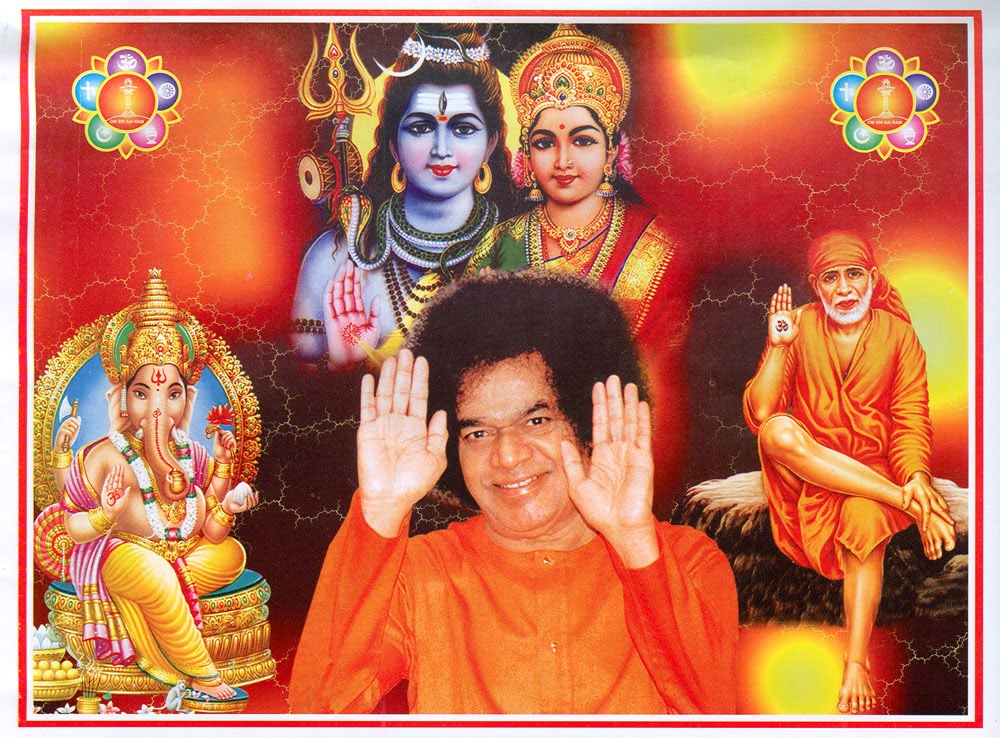







No hay comentarios :
Publicar un comentario